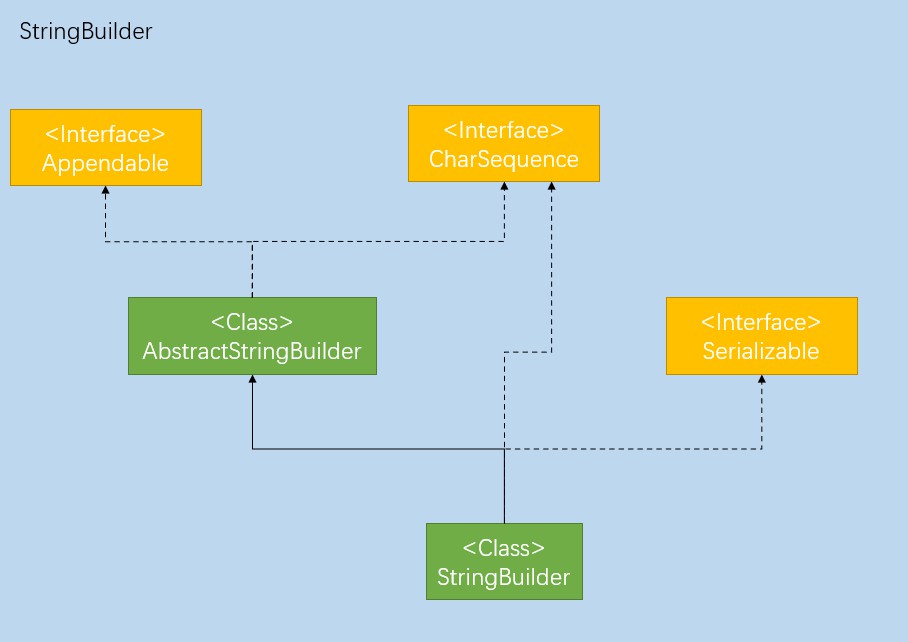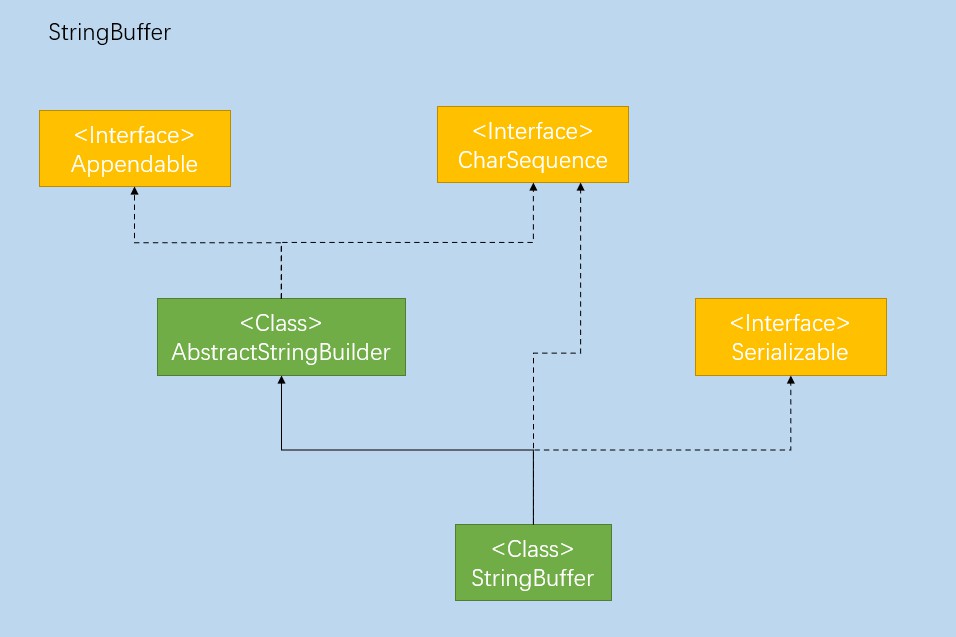StringBuilder、StringBuffer源碼分析 StringBuilder源碼分析 類結構 StringBuilder使用final關鍵字修飾,和String一樣不可以被繼承 StringBuilder繼承AbstractStringBuilder並實現了Serializable和Ch ...
StringBuilder、StringBuffer源碼分析
StringBuilder源碼分析
類結構
public final class StringBuilder
extends AbstractStringBuilder
implements java.io.Serializable, CharSequence

StringBuilder使用final關鍵字修飾,和String一樣不可以被繼承
StringBuilder繼承AbstractStringBuilder並實現了Serializable和CharSequence,可以被序列化
方法
StringBuilder 的方法多是直接調用父類AbstractStringBuilder的方法,這裡找幾個典型的方法看一下
StringBuilder append(Object obj)方法重寫父類的方法,追加Object類型的元素
@Override
public StringBuilder append(Object obj) {
return append(String.valueOf(obj));//String.valueOf(obj)獲取對象轉換成的字元串
}
public static String valueOf(Object obj) {
return (obj == null) ? "null" : obj.toString();
}
@Override
public StringBuilder append(String str) {
super.append(str);
return this;
}
public AbstractStringBuilder append(String str) {
if (str == null)
return appendNull();//如果為null追加字元串“null”
int len = str.length();
ensureCapacityInternal(count + len);
//拷貝字元串到數組
str.getChars(0, len, value, count);
count += len;
return this;
}
StringBuilder delete(int start, int end)刪除指定起點下標到指定結束下標的字元
@Override
public StringBuilder delete(int start, int end) {
super.delete(start, end);
return this;
}
public AbstractStringBuilder delete(int start, int end) {
if (start < 0)
throw new StringIndexOutOfBoundsException(start);
if (end > count)//如果結束下標>當前保存char的最大下標,直接賦值為最大下標
end = count;
if (start > end)
throw new StringIndexOutOfBoundsException();
int len = end - start;
if (len > 0) {
//把刪除尾下標後的元素拷貝到刪除起始下標後
System.arraycopy(value, start+len, value, start, count-end);
count -= len;
}
return this;
}
StringBuilder replace(int start, int end, String str)使用字元串替換指定範圍內的字元
@Override
public StringBuilder replace(int start, int end, String str) {
super.replace(start, end, str);
return this;
}
public AbstractStringBuilder replace(int start, int end, String str) {
if (start < 0)
throw new StringIndexOutOfBoundsException(start);
if (start > count)
throw new StringIndexOutOfBoundsException("start > length()");
if (start > end)
throw new StringIndexOutOfBoundsException("start > end");
if (end > count)
end = count;
int len = str.length();
//計算需要的容量
int newCount = count + len - (end - start);
//擴容
ensureCapacityInternal(newCount);
//刪除指定範圍的字元
System.arraycopy(value, end, value, start + len, count - end);
//在刪除的起始位置插入字元串
str.getChars(value, start);
count = newCount;
return this;
}
StringBuilder insert(int offset, Object obj)在指定位置插入對象
@Override
public StringBuilder insert(int offset, Object obj) {
super.insert(offset, obj);
return this;
}
public AbstractStringBuilder insert(int offset, Object obj) {
return insert(offset, String.valueOf(obj));//String.valueOf(obj)獲取對象轉換的字元串
}
public static String valueOf(Object obj) {
return (obj == null) ? "null" : obj.toString();
}
@Override
public StringBuilder insert(int offset, String str) {
super.insert(offset, str);
return this;
}
public AbstractStringBuilder insert(int offset, String str) {
if ((offset < 0) || (offset > length()))
throw new StringIndexOutOfBoundsException(offset);
if (str == null)
str = "null";
int len = str.length();
//擴容
ensureCapacityInternal(count + len);
//把要插入位置後一定數量的字元(插入字元串長度)串移動後移一定距離(插入字元串長度)
System.arraycopy(value, offset, value, offset + len, count - offset);
//插入要插入的字元串
str.getChars(value, offset);
count += len;
return this;
}
可以看到,StringBuilder的append、insert、replace、delete都是對父類的char數組進行的一些操作,並沒有產生新的對象
String toString() 最精髓的一個方法
@Override
public String toString() {
//把進過一些列修改後的最終char數組生成String
return new String(value, 0, count);
}
這裡我們看到在toString的時候,把char數組生成了String,這也是為什麼StringBuilder比String效率高的原因,String類沒做一點修改都會生成新的對象,那麼在頻繁拼串和截取字元串時,效率當然不如StringBuilder
StringBuffer源碼分析
類結構
public final class StringBuffer
extends AbstractStringBuilder
implements java.io.Serializable, CharSequence

StringBuffer的類結構和StringBuilder的一樣
方法
StringBuffer和StringBuilder一樣,很多方法都是調用父類AbstractStringBuilder的方法,我們看幾個最主要的方法
StringBuffer append(Object obj)向StringBuffer中追加對象,和StringBuilder的追加對象一樣的代碼
@Override
public synchronized StringBuffer append(Object obj) {
toStringCache = null;
super.append(String.valueOf(obj));
return this;
}
public AbstractStringBuilder append(String str) {
if (str == null)
return appendNull();
int len = str.length();
ensureCapacityInternal(count + len);
str.getChars(0, len, value, count);
count += len;
return this;
}
public void getChars(int srcBegin, int srcEnd, char dst[], int dstBegin) {
if (srcBegin < 0) {
throw new StringIndexOutOfBoundsException(srcBegin);
}
if (srcEnd > value.length) {
throw new StringIndexOutOfBoundsException(srcEnd);
}
if (srcBegin > srcEnd) {
throw new StringIndexOutOfBoundsException(srcEnd - srcBegin);
}
System.arraycopy(value, srcBegin, dst, dstBegin, srcEnd - srcBegin);
}
StringBuffer delete(int start, int end)刪除指定範圍內的字元,和StringBuilder中delete方法代碼一樣
@Override
public synchronized StringBuffer delete(int start, int end) {
toStringCache = null;
super.delete(start, end);
return this;
}
public AbstractStringBuilder delete(int start, int end) {
if (start < 0)
throw new StringIndexOutOfBoundsException(start);
if (end > count)
end = count;
if (start > end)
throw new StringIndexOutOfBoundsException();
int len = end - start;
if (len > 0) {
System.arraycopy(value, start+len, value, start, count-end);
count -= len;
}
return this;
}
StringBuffer replace(int start, int end, String str)方法使用字元串替換指定範圍內的字元,和StringBuilder的replace方法代碼一樣
@Override
public synchronized StringBuffer replace(int start, int end, String str) {
toStringCache = null;
super.replace(start, end, str);
return this;
}
public AbstractStringBuilder replace(int start, int end, String str) {
if (start < 0)
throw new StringIndexOutOfBoundsException(start);
if (start > count)
throw new StringIndexOutOfBoundsException("start > length()");
if (start > end)
throw new StringIndexOutOfBoundsException("start > end");
if (end > count)
end = count;
int len = str.length();
int newCount = count + len - (end - start);
ensureCapacityInternal(newCount);
System.arraycopy(value, end, value, start + len, count - end);
str.getChars(value, start);
count = newCount;
return this;
}
StringBuffer insert(int offset, Object obj)在指定位置插入字元串,也是和StringBuilder的insert方法代碼一樣
@Override
public synchronized StringBuffer insert(int offset, Object obj) {
toStringCache = null;
super.insert(offset, String.valueOf(obj));
return this;
}
public AbstractStringBuilder insert(int offset, String str) {
if ((offset < 0) || (offset > length()))
throw new StringIndexOutOfBoundsException(offset);
if (str == null)
str = "null";
int len = str.length();
ensureCapacityInternal(count + len);
System.arraycopy(value, offset, value, offset + len, count - offset);
str.getChars(value, offset);
count += len;
return this;
}
通過分析這幾個方法源碼,我們可以看到,StringBuilder和StringBuffer在方法的實現上是一致的,唯一的區別是StringBuffer的所有方法都加了synchronized鎖,所以是線程安全的
String toString()把StringBuffer轉換成字元串
@Override
public synchronized String toString() {
if (toStringCache == null) {
toStringCache = Arrays.copyOfRange(value, 0, count);
}
return new String(toStringCache, true);
}
StringBuffer與StringBuilder都是在修改的時候並沒有產生新的對象,只是在調用toString方法是才轉換為字元串。
總結
- StringBuilder和StringBuffer的類結構是一致的,都是使用父類的char數組保存字元。
- StringBuffer的所有方法都加了synchronized鎖,所以是線程安全的,但是這也使得它的效率比StringBuilder低。
- StringBuilder和StringBuffer的基本思想是一致的,對StringBuilder、StringBuffer的任何修改都不會產生新對象,這也使得StringBuilder、StringBuffer在進行大量拼串截取時比String的效率高。


